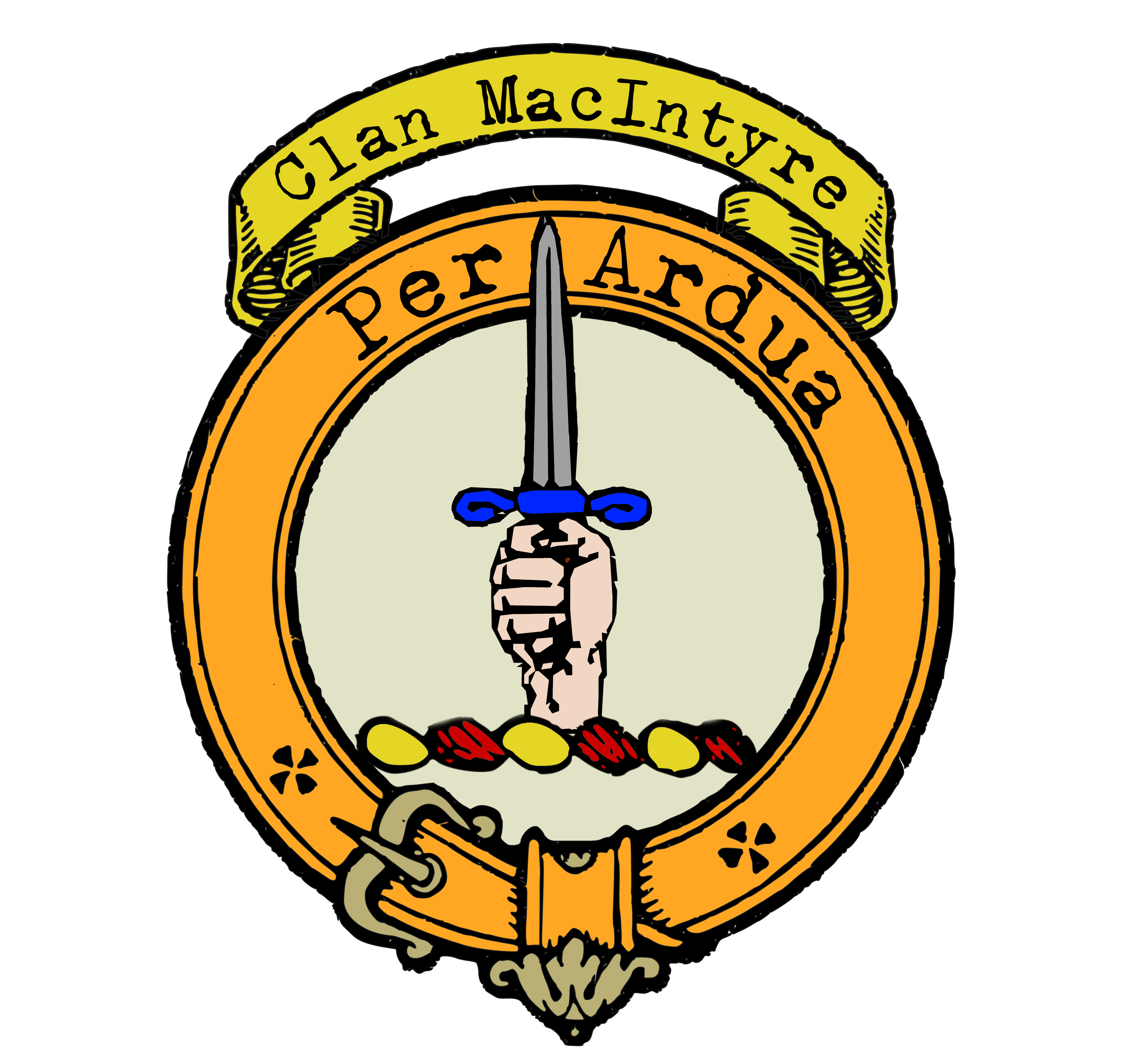Clan MacIntyre
|
|
CREST: A dexter hand holding a dagger in pale Proper MOTTO: Per ardua TRANSLATION: Through difficulties VARIATIONS: McIntyre |
 The MacIntyre name, Mac-an-Tsaoir in Gaelic, holds deep meaning – “son of the carpenter.” According to a traditional account, the clan’s origin can be traced back to the early twelfth century, during the time of Somerled’s lordship in the Western Isles. Somerled sought the hand of Ragnhild, the daughter of Olav the Red, Norse King of Man and the Isles. To secure the alliance, Somerled’s resourceful nephew, Macarill of Maurice, sabotaged Olav’s galley, saving the king’s life and earning the title of the “wright” or “carpenter.” This act not only established the MacIntyre lineage but also earned them high favor with Somerled. The MacIntyre name, Mac-an-Tsaoir in Gaelic, holds deep meaning – “son of the carpenter.” According to a traditional account, the clan’s origin can be traced back to the early twelfth century, during the time of Somerled’s lordship in the Western Isles. Somerled sought the hand of Ragnhild, the daughter of Olav the Red, Norse King of Man and the Isles. To secure the alliance, Somerled’s resourceful nephew, Macarill of Maurice, sabotaged Olav’s galley, saving the king’s life and earning the title of the “wright” or “carpenter.” This act not only established the MacIntyre lineage but also earned them high favor with Somerled.
Macarill’s descendants later settled in Glen Noe by Ben Cruachan on Loch Etive. Legend has it that they were guided by a mystical prophecy involving a white cow in their herd. As they sought a fertile land to call home, the cow’s resting place led them to the prosperous Glen Noe, nestled amidst breathtaking Scottish scenery. By the end of the thirteenth century, the MacIntyres found themselves as foresters to the Lord of Lorn, a position they held through changing ruling families. The MacIntyre clan’s influence continued to grow through strategic alliances. Duncan, the first recorded chief, married a daughter of Campbell of Barcaldine, and through this connection, they claimed descent from none other than Robert the Bruce, the legendary Scottish king. This lineage strengthened their standing within Scottish society and fortified their sense of pride and heritage. During times of turmoil, clans were often drawn into conflicts. The MacIntyres found themselves entangled in the civil war in Scotland and took sides based on their alliances. While many MacIntyres joined the royalist forces led by Alasdair Macdonald, ‘Colkitto,’ due to their perceived kinship, the chief himself was with the Earl of Argyll’s forces at Inverlochy in 1645 when they suffered a surprise defeat against Montrose. This event highlighted the complexities and loyalties clans navigated during turbulent periods. The MacIntyre clan produced notable figures who left an indelible mark on Scottish history. James, the third chief, was not only a scholar and poet but also a man torn between loyalty and personal convictions during the Jacobite uprising in 1745. Despite his desire to join Prince Charles Edward Stuart, he succumbed to the influence of his Campbell wife and neighbors. However, many MacIntyres fought under Stewart of Appin at Culloden, while the esteemed bard Duncan Ban Macintyre fought for the house of Hanover at the Battle of Falkirk. The MacIntyres held their lands through feudal obligations to the Campbells, but as the 18th century dawned, financial pressures mounted. Cash rents were imposed, and the increasing burden forced Donald, the fourth recorded chief, to emigrate to America in 1783. Duncan, his brother, struggled to manage the estate until 1806 when he, too, departed Glen Noe. This marked a significant shift in the clan’s trajectory, as they continued to honor their Scottish origins in the new world, preserving their heritage through cherished symbols and artifacts. In recent history, Clan MacIntyre has experienced a renaissance of its ancestral legacy. In 1955, Alasdair Macintyre of Camus-na-h-Erie recorded arms as a cadet of the chiefly house of MacIntyre. However, it was in 1991 that James Wallace Macintyre of Glenoe, the ninth recorded chief, matriculated the correct undifferenced arms, restoring the MacIntyres’ rightful place among the council of clan chiefs. Today, Clan MacIntyre stands proudly, ensuring the preservation of their heritage and offering a glimpse into the rich tapestry of Scotland’s cultural mosaic. |
|
Citations:
|
|

Purchase @ Redbubble
Purchase @ Amazon.com
Purchase @ Amazon.co.uk

